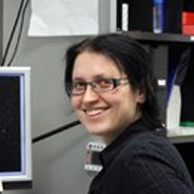Sensing with colors
Felicia Ungureanu
Promotion date: 6. September 2012
Promotor: Prof. dr. Vinod Subramaniam
Assistant promotor: Dr. Rob Kooyman
| A new optical method is introduced, based on monitoring properties of many individual gold nanoparticles for the detection of low concentrations of biomolecules. The proof of principle was demonstrated and the performance of the method was determined in an application for protein detection and quantification. Two different sensing strategies were investigated: the label-free and amplified assay. Additionally, introduced was the concept of parallel detection of multiple individually addressed nanoparticles, capable of determining analyte concentrations, orders of magnitude below the inverse affinity constant.. The theoretical findings were experimentally validated in the remaining of the manuscript. The colorimetric detection method of binding events on individual gold nanoparticles as sensing elements, was presented. An analysis software has been developed to translate the colour changes of the gold nanoparticles, due to binding events into quantified values (e.g. the number of proteins and the number of binding events). Single binding events can be detected using colorimetric dark field microscopy. The results presented here, combine single molecule sensitivity with parallel detection ability, multiplexing and general applicability to most specific binding reactions. |
Were novel research characteristics involved in your PhD research?
The main aim in our project was to develop a new optical method for the detection of very low concentrations of molecules using gold nanoparticles as sensing platforms. The physical principle consists of monitoring spectral shifts due to molecular binding on multiple individual gold nanoparticles. The novelty in our method is given by the detection principle. Here a colour camera is employed, to visualize multiple individual coloured dots each of them representing an individual nanoparticle, and monitor the changes in the colour of these dots while biomolecules bind to them.
The method is tempting, as the basic idea is very simple: one immediately can notice something is happening to the nanoparticles involved. By looking at thousands of such particles, and making a ratio between the number of particles that show a change and the total number of particles present in an image, one can determine a coverage rate (gamma) which can give us the concentration of the biomolecules.
This approach was never done before. As a team, we tried to translate colour changes into quantitative measurements (concentrations). For this purpose, a lot of theoretical studies were involved: to correlate the change in colour of the “nanoparticle” - observed with a colour camera - to a spectral shift and then to a number of biomecules bound per particle.
Two major advantages can be derived from this method: (1) quantification possibilities and (2) the multiplexing, or the possibility to measure multiple species of biomolecules in the same time. Because nanoparticles with various sizes or shapes show different colours, a colour camera can easily distinguish between them. By functionalizing each nanoparticle type with various receptors for distinctive biomolecules, multiple species can be easily detected simultaneously.
Initially the project was towards better measurements concerning the DNA of shi-take mushrooms. Along the way we came up with this method and took up the full area of new research attention, varying from the theory behind all this, experimentation and software development from using the high quality images of the camera.
Was there a special moment during your project, that you recall?
I can say without doubts that the first time I demonstrated that we can detect single binding events using our method, was the most important moment in our project. Because we started this project from scratch and everything was new, doubts were building in.
This poof was a great relief to the team, showing that the method used really was working.
When the scepticism had gone, I performed my analyses and experiments with confidence. This way we were able to demonstrate not only that our method works, also its detection limits (nM for protein detection and fM for DNA detection).
Did it lead to some nice publications?
We had publications in Sensors and Actuators and in Biosensors and Bioelectronics. The titles were: Immunosensing by colorimetric darkfield microscopy of individual gold nanoparticle- conjugates, and: Femtomolar DNA detection by parallel colorimetric darkfield microscopy of functionalized gold nanoparticles.
In what way did the PhD project affect you as a researcher and scientist?
I grew up in many aspects, one could say. I have matured in using my lab skills and in my level of theoretical knowledge. Now I feel like a better, improved scientist, very different from the one I was as a young master graduate.
At first my lab work consisted of ninety percent experimentation and ten percent of organizing my project properly. Now this ratio is switched completely, working much more efficiently. In addition, I know more clearly beforehand what I want to achieve.
What are your future plans?
In my future job, I would like a great deal of research in Life Sciences to be involved. I feel, I am able to give a lot in this field of research. Also I would like microscopy techniques to be involved too, no matter if the research is academic in nature or is taking place in a commercial setting.
What, in your opinion, is important for Mesa+ to stay successful in future?
The facilities at Mesa+ are incredible, as is the expertise and collaboration ability of the technicians. What is shown in sci-fi movies is already possible at Mesa+, I am proud to say, for example the high image microscopy I was able to work with. Being part of people working with this high standard equipment, is a real honor. Keeping up these standards will continue to make Mesa+ known all over the world, as it is the case now already.

